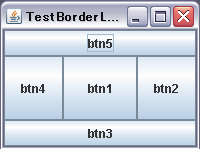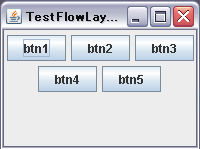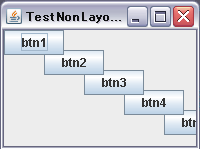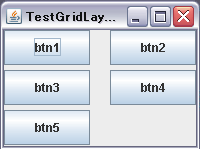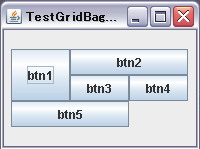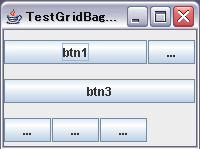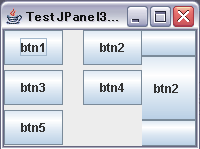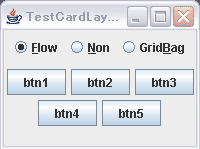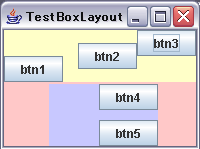| BorderLayout |
package test;
import java.awt.BorderLayout;//配置のクラスの一つ
import javax.swing.JPanel;
import javax.swing.JFrame;
import javax.swing.JButton;
public class BorderLayoutPanel extends JPanel{
JButton []btn = new JButton[5];//ボタン配列
public BorderLayoutPanel(){
this.setLayout(new BorderLayout());//BorderLayoutの配置に設定
this.add(btn[0] = new JButton("btn1"), BorderLayout.CENTER);
this.add(btn[1] = new JButton("btn2"), BorderLayout.EAST);
this.add(btn[2] = new JButton("btn3"), BorderLayout.SOUTH);
this.add(btn[3] = new JButton("btn4"), BorderLayout.WEST);
this.add(btn[4] = new JButton("btn5"), BorderLayout.NORTH);
}
public static void main(String[] args){
new TestBorderLayout();
JFrame frm2 = new TestBorderLayout();
frm2.setBounds(100, 150, 300, 250);
}
}
class TestBorderLayout extends JFrame
{
public TestBorderLayout(){
this.setDefaultCloseOperation(JFrame.DISPOSE_ON_CLOSE);
this.setTitle("TestBorderLayout");
JPanel panel = new BorderLayoutPanel();
this.setContentPane(panel);
this.setBounds(0, 0, 200, 150);
this.setVisible(true);
}
}
|
|---|---|
これまで使ってきた |
|
| FlowLayout |
package test;
import java.awt.FlowLayout;//配置のクラスの一つ
import javax.swing.JPanel;
import javax.swing.JFrame;
import javax.swing.JButton;
public class FlowLayoutPanel extends JPanel
{
JButton[] btn = new JButton[5];//ボタン配列
public FlowLayoutPanel(){
this.setLayout(new FlowLayout());
//↑FlowLayoutの配置に設定(このクラスがJPanelなので、省略しても同じ)
for (int i = 0; i < this.btn.length; i++){
btn[i] = new JButton("btn" + (i + 1));
this.add(btn[i]);
}
}
public static void main(String[] args){
new TestFlowLayout();
JFrame frm2 = new TestFlowLayout();
frm2.setBounds(100, 150, 300, 250);
}
}
class TestFlowLayout extends JFrame
{
public TestFlowLayout() {
this.setDefaultCloseOperation(JFrame.DISPOSE_ON_CLOSE);
this.setTitle("TestFlowLayout");
JPanel panel = new FlowLayoutPanel();
this.setContentPane(panel);
this.setBounds(0, 0, 200, 150);
this.setVisible(true);
}
}
|
これは、 |
|
| 絶対位置指定レイアウト |
package test;
import java.awt.FlowLayout;//配置のクラスの一つ
import javax.swing.JPanel;
import javax.swing.JFrame;
import javax.swing.JButton;
public class NonLayoutPanel extends JPanel
{
JButton []btn = new JButton[5];//ボタン配列
public NonLayoutPanel()
{
this.setLayout( null );//Layout指定なし
for(int i = 0; i < this.btn.length; i++){
btn[i] = new JButton("btn" + (i + 1));
btn[i].setBounds(i * 40, i * 20, 60, 25);//位置と幅を指定
this.add( btn[i] );
}
this.setBounds(0, 0, 200, 150);
this.setVisible(true);
}
public static void main(String[] args){
new TestNonLayout();
JFrame frm2 = new TestNonLayout();
frm2.setBounds(100, 150, 300, 250);
}
}
class TestNonLayout extends JFrame {
public TestNonLayout(){
this.setDefaultCloseOperation(JFrame.DISPOSE_ON_CLOSE);
this.setTitle("TestNonLayout");
JPanel panel = new NonLayoutPanel();
this.setContentPane(panel);
this.setBounds(0, 0, 200, 150);
this.setVisible(true);
}
}
|
これはsetLayoutで、 |
|
| GridLayout |
package test;
import java.awt.GridLayout;//配置のクラスの一つ
import javax.swing.JPanel;
import javax.swing.JFrame;
import javax.swing.JButton;
public class GridLayoutPanel extends JPanel{
JButton []btn = new JButton[5];//ボタン配列
public GridLayoutPanel(){
GridLayout layout = new GridLayout(3,2); // 3行,2列
this.setLayout(layout);
layout.setVgap(5);//垂直方向の間隔
layout.setHgap(20);//水平方向の間隔
for(int i = 0; i < this.btn.length; i++){
this.btn[i] = new JButton("btn" + (i + 1));
this.add(btn[i]);
}
}
public static void main(String[] args){
new TestGridLayout();
JFrame frm2 = new TestGridLayout();
frm2.setBounds(100, 150, 300, 250);
}
}
class TestGridLayout extends JFrame
{
public TestGridLayout(){
this.setDefaultCloseOperation(JFrame.DISPOSE_ON_CLOSE);
this.setTitle("TestGridLayout");
JPanel panel = new GridLayoutPanel();
this.setContentPane(panel);
this.setBounds(0, 0, 200, 150);
this.setVisible(true);
}
}
|
部品を格子状に |
|
| GridBagLayout |
package test;
import java.awt.GridBagLayout;//配置のクラスの一つ
import java.awt.GridBagConstraints;//配置コンポーネントの配置制約指定用
import java.awt.Insets;//コンテナの境界を表現するクラス
import javax.swing.JPanel;
import javax.swing.JFrame;
import javax.swing.JButton;
public class GridBagLayoutPanel extends JPanel{
JButton []btn = new JButton[5];//ボタン配列
public GridBagLayoutPanel()
{
GridBagLayout layout = new GridBagLayout();
this.setLayout(layout);
GridBagConstraints constraints = new GridBagConstraints();//制約に使うオブジェクト
//constraints.fill = GridBagConstraints.BOTH;//【1】縦横にコンポーネットサイズを満たすように配置
//constraints.weightx = 10.0;//【2】余分の水平スペースを分配
//constraints.weighty = 10.0;//【3】余分の垂直スペースを分配
//constraints.insets = new Insets(2, 2, 2, 2);//【4】隙間
constraints.gridx = 0; //位置x
constraints.gridy = 0; //位置y
constraints.gridwidth = 1; //コンポーネントの表示領域のセル数 横
constraints.gridheight = 2; //コンポーネントの表示領域のセル数 縦
layout.setConstraints(btn[0] = new JButton("btn1"), constraints);//現在の制約を使い
this.add(btn[0]);
constraints.gridx = 1; //位置x
constraints.gridy = 0; //位置y
constraints.gridwidth = 2; //コンポーネントの表示領域のセル数 横
constraints.gridheight = 1; //コンポーネントの表示領域のセル数 縦
layout.setConstraints(btn[1] = new JButton("btn2"), constraints);//現在の制約を使い
this.add(btn[1]);
constraints.gridx = 1; //位置x
constraints.gridy = 1; //位置y
constraints.gridwidth = 1; //コンポーネントの表示領域のセル数 横
constraints.gridheight = 1; //コンポーネントの表示領域のセル数 縦
layout.setConstraints(btn[2] = new JButton("btn3"), constraints);//現在の制約を使い
this.add(btn[2]);
constraints.gridx = 2; //位置x
constraints.gridy = 1; //位置y
layout.setConstraints(btn[3] = new JButton("btn4"), constraints);//現在の制約を使い
this.add(btn[3]);
constraints.gridx = 0; //位置x
constraints.gridy = 2; //位置y
constraints.gridwidth = 2; //コンポーネントの表示領域のセル数 横
layout.setConstraints(btn[4] = new JButton("btn5"), constraints);//現在の制約を使い
this.add(btn[4]);
}
public static void main(String[] args){
new TestGridBagLayout();
JFrame frm2 = new TestGridBagLayout();
frm2.setBounds(100, 150, 300, 250);
}
}
class TestGridBagLayout extends JFrame
{
public TestGridBagLayout()
{
this.setDefaultCloseOperation(JFrame.DISPOSE_ON_CLOSE);
this.setTitle("TestGridBagLayout");
JPanel panel = new GridBagLayoutPanel();
this.setContentPane(panel);
this.setBounds(0, 0, 200, 150);
this.setVisible(true);
}
}
|
部品を格子状に
指定するものですが、
その時配置する位置と
大きさを指定できます。
|
|
| GridBagLayout 例2 |
package test;
import java.awt.GridBagLayout;//配置のクラスの一つ
import java.awt.GridBagConstraints;//配置コンポーネントの配置制約指定用
import java.awt.Insets;//コンテナの境界を表現するクラス
import javax.swing.JPanel;
import javax.swing.JFrame;
import javax.swing.JButton;
public class GridBagLayoutPanel2 extends JPanel{
JButton []btn = new JButton[6];//ボタン配列
public GridBagLayoutPanel2()
{
GridBagLayout layout = new GridBagLayout();
this.setLayout(layout);
GridBagConstraints constraints = new GridBagConstraints();//制約に使うオブジェクト
//constraints.fill = GridBagConstraints.BOTH;//【1】縦横にコンポーネットサイズを満たすように配置
constraints.weightx = 1.0;//余分の水平スペースを分配
constraints.weighty = 1.0;//余分の垂直スペースを分配
constraints.insets = new Insets(10, 0, 5, 1);//上隙間,左隙間,下隙間,右隙間
constraints.gridx = 0; //位置x
constraints.gridy = 0; //位置y
constraints.gridwidth = 3; //コンポーネントの表示領域のセル数 横
constraints.gridheight = 1; //コンポーネントの表示領域のセル数 縦
layout.setConstraints(btn[0] = new JButton("btn1"), constraints);//現在の制約を使い
this.add(btn[0]);
constraints.gridx = 3; //位置x
constraints.gridy = 0; //位置y
constraints.gridwidth = 1; //コンポーネントの表示領域のセル数 横
layout.setConstraints(btn[1] = new JButton("btn2"), constraints);//現在の制約を使い
this.add(btn[1]);
constraints.gridx = 0; //位置x
constraints.gridy = 1; //位置y
constraints.gridwidth = 4; //コンポーネントの表示領域のセル数 横
layout.setConstraints(btn[2] = new JButton("btn3"), constraints);//現在の制約を使い
this.add(btn[2]);
constraints.gridx = 0; //位置x
constraints.gridy = 2; //位置y
constraints.gridwidth = 1; //コンポーネントの表示領域のセル数 横
layout.setConstraints(btn[3] = new JButton("btn4"), constraints);//現在の制約を使い
//this.add(btn[3]);【2】
constraints.gridx = 1; //位置x
constraints.gridy = 2; //位置y
layout.setConstraints(btn[4] = new JButton("btn5"), constraints);//現在の制約を使い
//this.add(btn[4]);【3】
constraints.gridx = 2; //位置x
constraints.gridy = 2; //位置y
layout.setConstraints(btn[5] = new JButton("btn6"), constraints);//現在の制約を使い
//this.add(btn[5]);//【4】
}
public static void main(String[] args){
new TestGridBagLayout2();
JFrame frm2 = new TestGridBagLayout2();
frm2.setBounds(100, 150, 300, 250);
frm2.validate();
}
} |
部品を格子状で、
位置と
大きさを指定して、
配置できるのですが、
配置する部品が、
それぞれの格子座標に対し、
一箇所以上で指定しないと、
希望のサイズや位置にならない場合があります。 |
